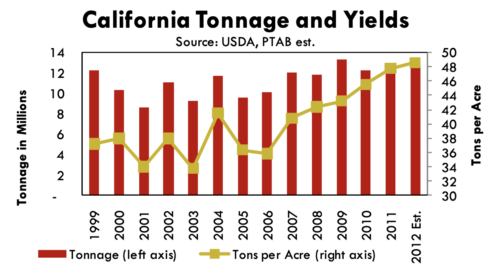 With the most recent tomato harvest completed, it appears California’s fields produced record setting yields resulting in the state’s second-largest crop. Preliminary numbers show vol‐ ume at just over 12.6 million tons, 5.8% above last year and 5.1% shy of the 13.3 million ton record set in 2009.
With the most recent tomato harvest completed, it appears California’s fields produced record setting yields resulting in the state’s second-largest crop. Preliminary numbers show vol‐ ume at just over 12.6 million tons, 5.8% above last year and 5.1% shy of the 13.3 million ton record set in 2009.
For the 5th straight year, California’s field yields set a record. Unofficially, 2012 yields are over 48 tons per acre on 260,000 acres. Although many things factor into field yields, drip irrigation is often credited for the stable and ever-improving yields.
For the most part the harvest was uneventful. As has been the pattern in recent years, the season started two weeks later than planned due to a wet, cool spring which delayed planting and fruit development.
Harvesting began in earnest in mid‐July and processing reached full tilt in early August. As the summer pushed on, deliveries to the factories exceeded 1 million tons for 7 weeks. Despite the high field yields, the factories processed tomatoes as they ripened and didn’t fall behind the crop.
Harvesting slowed down by the end of September and the season wrapped up in the middle of Oc‐ tober, just as rains hit.
Overall, the tomato quality was reportedly good, but Natural Tomato Soluble Solids (NTSS) was a bit low. High NTSS is important for paste factory efficiency as lower solids mean more water needs to be evaporated to reach the solids target of paste. At 5.16 average for the season, 2012 NTSS was 2.6% lower than the 5 year average of 5.3 NTSS, based on reports from the Processing Tomato Advisory Board. PTAB operates the tomato grading program statewide.
Although California has seen a lot of sunshine this fall, the Octo‐ ber rains have helped buffer against drought. According to the California Department of Water Resources, precipitation is 85% of average for July through October and reservoir storage is 95% of average.

Morning Star Newsletter now distributed electronically
As a reminder, Morning Star is now distributing our newsletters electronically using an email distribution vendor called Mailchimp. Your e-version will now include informative Morning Star videos and highlights. Depending on your company's firewall, these emails may initially be directed to you spam folder.

